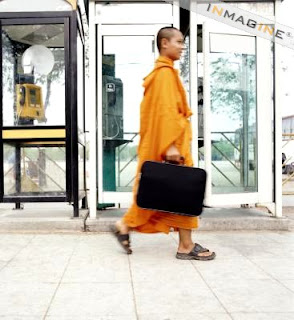
Today is one of the feast days for the Egyptian cleric Anthony the Great, who is universally celebrated in the Western liturgical churches as the father of Christian monasticism.
Sets my mind to thinking about monasticism, although for me what the monastic life has meant for Zen Buddhism and especially for Zen in the West.
Buddhism has been carried by the monastic sangha since its inception. In fact in strict traditional usage the term sangha, which today is used in the same sense as church in that it is applied to both local groups and the larger community, was originally reserved to designate monks and nuns, only.
When Zen or more properly Chan emerged in early medieval China the peculiar acknowledgment of realization that uniquely marked the Zen way was bestowed upon monastics and lay alike. But as it normalized as a sense of lineage, it also became more and more exclusively the domain of monastics, and mostly male monastics.
It’s in Japan that things got all mixed up.
And as an heir to the Japanese Zen traditions, it draws my attention constantly, both for its wonderful gifts, and for its looming shadows.
The Japanese Soto master Eihei Dogen had been ordained within a reforming model that departed from the normative vinaya codes. Instead, drawing upon a precept model derived from the enormously popular Brahmajala Sutra (a Chinese Mahayana text not to be confused with an earlier Theravandan document). And this model became normative (with slight variations of understanding) for monastic ordination in Japan in both the Soto and Rinzai lines.
This would open a gap between Japanese and continental Buddhism somewhat similar to the gap between Anglican ordination and Catholic, where those who follow the older model consider those ordained within the new model as at best pious lay people embracing monastic robes and nomenclature and at worst as poseurs. Wandering the web one can see this gap and its attendant disputes continue…
Things became more complicated through the shift to a married clergy in Japan. The Shin traditions embraced this with full abandon. The Zen schools were, however, conflicted.
The language of Zen ordination in Japan remains monastic. However the overwhelming larger number of those ordained are married and function more as priests or ministers than monks or nuns.
There is also an appeal to the monastic ideals that runs through the Japanese derived Zen traditions that continues to mark Zen as it has come West. Sometimes to the good. To my mind more often to the ill.
The monastic training model is to throw one’s life into the training schedule. This includes commitments to extended periods of time in training practice. A consequence of this is that folk who ordain in the Zen traditions at some point discover there is no monastic community or lay base to support them, but they have no marketable skills outside the community.
As we move into the sixth decade of serious Zen practice in the West, and specifically in the United States, this is looming large with people who are approaching retirement age, if they’re not already there, but who don’t even have social security.
A few of us saw the problem and made other arrangements.
For me it was a quest that led to an integrated spiritual practice weaving a life as a Unitarian Universalist and then UU minister together with my life as a committed Zen practitioner and eventually teacher. Others have made other accommodations, probably most commonly within the psychological and therapeutic professions.
That shadow, and it is a terrible one, acknowledged, there remains something compelling and powerful about the monastic call.
And here, for the last few moments of this reflection I want to address the power of the monastic way.
I believe those who have chosen the convent, particularly if they chose well, and belong to a self-sustaining community, have given themselves over to a great work. And we just don’t know what blessings this brings to our world. But I believe in my heart these blessings are vast.
And, I think our various attempts as western Zen practitioners to find accommodations between the deep currents that inform the monastic call into ordinary lives, lives committed to being found and deepened and expressed in the world, may well also bring gifts to the world.
Of course, the rule of thumb is bringing an open heart, and a deep curiosity, best expressed as not knowing, and to fully give this one precious life to the project…












